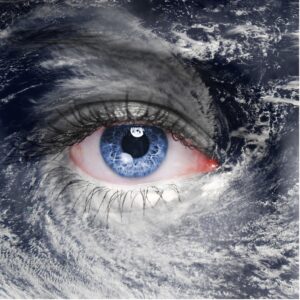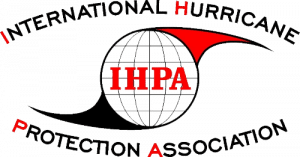What does “Eye of the Storm” Mean?

Meteorologists know a hurricane is strengthening quickly when a pinhole eye appears on a satellite.
It’s known to some as the dreaded pinhole because it tells meteorologists that there’s likely a significant hurricane associated with the storm’s small eye.
Parts of a Hurricane
Hurricanes consist of three major parts: the eye, eyewall, and rainbands. The eye is the calmest part of the hurricane, located in the center. Rain bands extend for hundreds of miles around the storm, carrying rain, clouds, thunderstorms, and sometimes tornadoes. This is the hurricane area that begins to move in a circular motion around the rest of the storm. The eyewall is closer to the center, which begins to form as the storm becomes more robust due to the formation of convection and upward-moving air. This eyewall is where the winds are strongest and heavy thunderstorms occur. In the very center of the storm is the eye of the hurricane. In fact, it is the formation of the eye of a hurricane that allows weather forecasters and meteorologists to determine that the hurricane is gaining strength. The eye appears clear with few clouds and has lower wind speeds than the rest of the hurricane. However, it is not as calm as it appears.
The Eye
The entire hurricane rotates around the eye, and it is usually 20-60 miles in diameter. When this part of the hurricane hits land, it is the calmest area inside of the storm. In fact, people often think the storm has passed and go outside only to be caught by the approaching eyewall. Overwater, however, the eye of a hurricane is one of the most dangerous places to be. Eyes less than 10 miles in diameter are known as a pinhole eye. Often, a pinhole eye is associated with a powerful hurricane. Some of the most destructive hurricanes have had pinhole eyes, and major hurricanes are classified as Category 3 or stronger.
Generally speaking, the smaller the eye of the hurricane, the faster it spins. Think of a dancer spinning on the dance floor. A dancer will spin slower when their arms and hands are extended out. When the dancer pulls their arms and hands closer to their body, the dancer spins faster. It’s known as the conservation of angular momentum, and the same physics apply to hurricanes. A smaller eye typically means stronger winds. Hurricanes with pinhole eyes are most common in the Caribbean Sea or the Gulf of Mexico.
If you’re ever in a situation where you can’t or don’t want to evacuate from your Florida home during a hurricane watch, we hope you heed this warning. The eye may seem deceptively calm, but it’s important you stay indoors when it passes overhead. Stay safe!

















